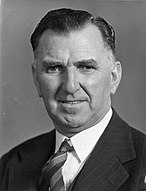New Zealand general election, 1949
|
|
|||||||||||||||||||||||||||||||||||||
|---|---|---|---|---|---|---|---|---|---|---|---|---|---|---|---|---|---|---|---|---|---|---|---|---|---|---|---|---|---|---|---|---|---|---|---|---|---|
|
|||||||||||||||||||||||||||||||||||||
|
|
|||||||||||||||||||||||||||||||||||||
|
All 80 seats in the New Zealand Parliament 41 seats were needed for a majority |
|||||||||||||||||||||||||||||||||||||
| Turnout | 1,113,852 | ||||||||||||||||||||||||||||||||||||
|
|||||||||||||||||||||||||||||||||||||
|
|||||||||||||||||||||||||||||||||||||
The 1949 New Zealand general election was a nationwide vote to determine the shape of the New Zealand Parliament's 29th term. It saw the governing Labour Party defeated by the opposition National Party. This marked the end of the First Labour government and the beginning of the First National government.
The Labour Party had formed its first administration after winning the 1935 elections, and had remained in power (with gradually decreasing majorities) since then. The National Party, formed by a merger of the parties which Labour had originally ousted, gradually increased its power in Parliament; the ineffectual Adam Hamilton was replaced by Sidney Holland, and internal disputes were gradually resolved. The Prime Minister, Peter Fraser, was increasingly weary. Ongoing shortages after World War II also eroded public support for the government. The National Party's decision not to repeal Labour's social welfare policies also increased its appeal.
The date for the main elections was a Wednesday 30 November. Elections to the four Māori electorates were held the day before—the 1949 elections were the last in which Māori voted on a different day. 1,113,852 people were registered to vote, although rolls for the Māori seats were "woefully inadequate." Voter turnout for the elections is disputed, given the problems with the Māori roll—some sources place it at 93.5 percent, while others estimate 92.9 percent. Regardless, the turnout was relatively high for the time. The number of seats being contested was 80, a number which had been fixed since 1902.
...
Wikipedia


